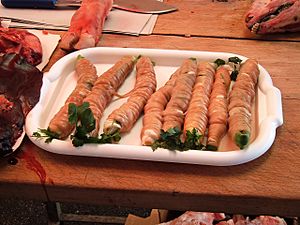Stigghiola facts for kids
The stigghiola (pronounced stee-GYOH-lah) is a special street food from Sicily, a large island in Italy. It's very popular in the city of Palermo. People often eat it right on the street!
This unique dish is made from the guts of animals, usually lamb, but sometimes goat or chicken. These parts are carefully cleaned with water and salt. Then, they are seasoned with fresh parsley and often onion and other green herbs.
After seasoning, the guts are either put onto a skewer (a long stick) or rolled around a leek. Finally, they are cooked directly on a grill until they are ready to eat.
Contents
What is Stigghiola?
Stigghiola is a traditional dish from Sicily. It is known as a "street food" because it's often cooked and sold by vendors right on the streets. This makes it easy for people to grab a quick and tasty bite while they are out and about.
How is Stigghiola Made?
Making stigghiola involves a few steps. First, the animal guts are thoroughly washed to make them clean. Then, they are seasoned with fresh herbs like parsley and sometimes onion. These seasonings give the stigghiola its special flavor. After seasoning, the guts are either put on a skewer or wrapped around a leek. This helps to hold them together while they cook.
Cooking Stigghiola
The final step is cooking. Stigghiola is traditionally cooked over an open grill. This gives it a smoky flavor and a nice crispy texture on the outside. When it's ready, it's usually served hot.
Where Can You Find Stigghiola?
Stigghiola is most famous in Palermo, the capital city of Sicily. You can often find street vendors selling it in busy markets or along the streets. It's a big part of the local food culture there.
Stigghiola in Ragusa
In another Sicilian city called Ragusa, there's a slightly different version of this dish. There, it's called turciniuna. Instead of being grilled, turciniuna is baked in a casserole dish. This gives it a different texture and taste compared to the grilled version.
A Traditional Italian Food
Stigghiola is so important to Italian culture that it is officially listed as a "traditional Italian food product." This means it's recognized by the Ministry of Agricultural, Food and Forestry Policies as a special part of Italy's food heritage.
See also
 In Spanish: Stigghiola para niños
In Spanish: Stigghiola para niños



